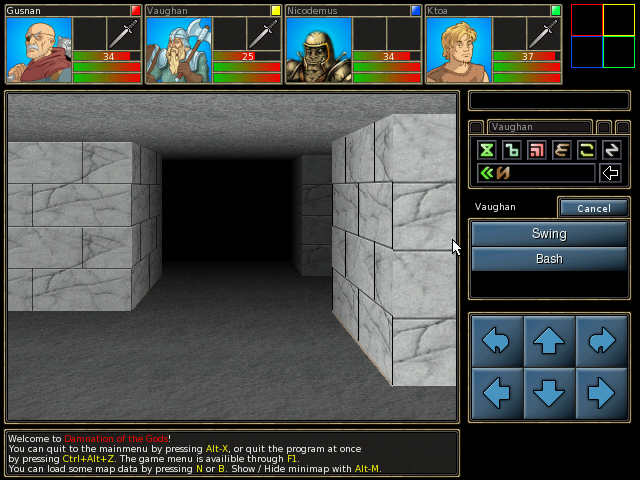|
Dragon View
''Dragon View'' is a side-scrolling role-playing beat 'em up released for the Super Nintendo Entertainment System in November 1994. Released in Japan as and otherwise known as ''Drakkhen II'', it is meant to be a sequel to ''Drakkhen'' although it bears little resemblance to its predecessor. It uses the same pseudo- 3D overworld system for which the series is most famous. Other features of ''Dragon View'' are its side-view action role-playing game (RPG) hybrid gameplay (used when exploring more detailed areas such as towns and dungeons), its well translated first-person storyline, and its emphasis on player-driven undirected exploration. In 2019, the game was re-released through emulation for Windows. In 2022, a reproduction SNES cartridge was released by Limited Run Games. Gameplay The ''Drakkhen'' series' most recognizable feature is its custom overworld engine. First used by the original Amiga version of ''Drakkhen'', it was later used in the PC and SNES ports. The ''Dragon ... [...More Info...] [...Related Items...] OR: [Wikipedia] [Google] [Baidu] |
Kemco
Kemco (abbreviated from Kotobuki Engineering & Manufacturing Co., Ltd.) is a Japanese video game developer and publisher established in 1984. It is headquartered in Kure, Hiroshima. One of its best known franchises is the ''Top Gear'' series, developed by Sheffield-based English developers Gremlin Graphics. History 1980s Kemco was founded in 1984 as Kotobuki System Co., Ltd. to be the video game subsidiary of the multifaceted corporation Kotobuki Engineering & Manufacturing Co., Ltd. (itself established in 1979). The Kemco name represents the initial letters of Kotobuki Engineering Manufacturing Co. Kemco started by developing video games for the Nintendo Entertainment System. Although technically called Kotobuki System until 2004, the company was already using the brand Kemco on its first game '' Dough Boy'' in 1985. In the late 1980s until the early 1990s, Kemco's video games were distributed in North America by Seika Corporation of Torrance, California under the joint lab ... [...More Info...] [...Related Items...] OR: [Wikipedia] [Google] [Baidu] |
Amiga
Amiga is a family of personal computers introduced by Commodore International, Commodore in 1985. The original model is one of a number of mid-1980s computers with 16- or 32-bit processors, 256 KB or more of RAM, mouse-based GUIs, and significantly improved graphics and audio compared to previous 8-bit systems. This includes the Atari ST—released earlier the same year—as well as the Macintosh and Acorn Archimedes. Based on the Motorola 68000 microprocessor, the Amiga differs from its contemporaries through the inclusion of custom hardware to accelerate graphics and sound, including sprite (computer graphics), sprites and a blitter, and a pre-emptive multitasking operating system called AmigaOS. The Amiga 1000 was released in July 1985, but production problems kept it from becoming widely available until early 1986. The best-selling model, the Amiga 500, was introduced in 1987 along with the more expandable Amiga 2000. The Amiga 3000 was introduced in 1990, followed by t ... [...More Info...] [...Related Items...] OR: [Wikipedia] [Google] [Baidu] |
Piko Interactive Games
Piko (stylized PIKO, pronounced "peek-oh") is a German model train brand in Europe that also exports to the United States and other parts of the world. History Founded in 1949, PIKO was once a state-owned enterprise in the German Democratic Republic (East Germany), supplying a share of model trains in Eastern Europe. In 1992, after the reunification of Germany, the company was purchased by PIKO Spielwaren GmbH. PIKO Spielwaren GmbH was founded in April 1992 by Dr. René F. Wilfer, PIKO’s President, who had been working in the toy industry since 1986 and had previously managed a model building company. Products PIKO manufactures more than 1,500 products in various model train scales: G-Scale: American and European-prototype weather-resistant models for indoor and outdoor use, including starter sets, locomotives, passenger and freight cars, track, buildings, controls and accessories. HO-Scale: European-prototype models including starter sets, locomotives (most in bot ... [...More Info...] [...Related Items...] OR: [Wikipedia] [Google] [Baidu] |
Kemco Games
This is a list of Kemco games. Of note, the video games in North America prior to 1992 were not published by Kemco themselves, but instead by their distributor Seika Corporation of Torrance, California, who used the label Kemco * Seika to market Kemco's titles in the region. Console-based games Original games Ports, localizations, and licensed games Digital games 2007 *''Alphadia'' (NTT DoCoMo Mobile Phone) 2008 *''Alphadia II'' (NTT DoCoMo Mobile Phone) *''Orleans no Otome: Jeanne D'Arc no Monogatari'' (NTT DoCoMo Mobile Phone) *''Sorcery Blade'' (WiiWare) 2009 *''Alphadia III'' (NTT DoCoMo Mobile Phone) *''Ayakashigatari'' (NTT DoCoMo Mobile Phone) *''Symphony of Eternity'' (NTT DoCoMo Mobile Phone) 2010 *''Alphadia IV'' (NTT DoCoMo Mobile Phone) *''Dark Gate'' (NTT DoCoMo Mobile Phone) *''Eve of the Genesis'' (NTT DoCoMo Mobile Phone) *''Fantasy Chronicle'' (NTT DoCoMo Mobile Phone) *''Symphony of Eternity'' (iOS & Android) 2011 *''Aeon Avenger'' (iOS & Android) *''Alphad ... [...More Info...] [...Related Items...] OR: [Wikipedia] [Google] [Baidu] |
Action Role-playing Video Games
An action role-playing game (often abbreviated action RPG or ARPG) is a subgenre of video games that combines core elements from both the action game and role-playing genre. Definition The games emphasize real-time combat where the player has direct control over the characters as opposed to turn or menu-based combat while still having a focus on character's Stats in order to determine relative strength and abilities. These games often use action game combat systems similar to hack and slash or shooter games. Action role-playing games may also incorporate action-adventure games, which include a mission system and role-playing game mechanics, or MMORPGs with real-time combat systems. History 1970s and early 1980s Allgame listed the following games released prior to 1984 as action RPGs: ''Temple of Apshai'' (1979) and its sequel ''Gateway to Apshai'' (1983), ''Beneath the Pyramids'' for the Apple II (1980), '' Bokosuka Wars'' (1983), and ''Sword of Fargoal'' (1983). Jeremy ... [...More Info...] [...Related Items...] OR: [Wikipedia] [Google] [Baidu] |
1994 Video Games
File:1994 Events Collage.png, From left, clockwise: The 1994 Winter Olympics are held in Lillehammer, Norway; The Kaiser Permanente building after the 1994 Northridge earthquake; A model of the MS Estonia, which sank in the Baltic Sea; Nelson Mandela casts his vote in the 1994 South African general election, in which he was elected South Africa's first president, and which effectively brought Apartheid to an end; NAFTA, which was signed in 1992, comes into effect in Canada, the United States, and Mexico; The first passenger rail service to utilize the newly-opened Channel tunnel; The 1994 FIFA World Cup is held in the United States; Skulls from the Rwandan genocide, in which over half a million Tutsi people were massacred by Hutus., 300x300px, thumb rect 0 0 200 200 1994 Winter Olympics rect 200 0 400 200 Northridge earthquake rect 400 0 600 200 Sinking of the MS Estonia rect 0 200 300 400 Rwandan genocide rect 300 200 600 400 Nelson Mandela rect 0 400 200 600 1994 FIF ... [...More Info...] [...Related Items...] OR: [Wikipedia] [Google] [Baidu] |
Electronic Gaming Monthly
''Electronic Gaming Monthly'' (often abbreviated to ''EGM'') is a monthly American video game magazine. It offers video game news, coverage of industry events, interviews with gaming figures, editorial content and product reviews. History The magazine was founded in 1988 as U.S. National Video Game Team's ''Electronic Gaming Monthly'' under Sendai Publications. In 1994, ''EGM'' spun off '' EGM²'', which focused on expanded cheats and tricks (i.e., with maps and guides). It eventually became '' Expert Gamer'' and finally the defunct '' GameNOW''. After 83 issues (up to June 1996), ''EGM'' switched publishers from Sendai Publishing to Ziff Davis. Until January 2009, ''EGM'' only covered gaming on console hardware and software. In 2002, the magazine's subscription increased by more than 25 percent. The magazine was discontinued by Ziff Davis in January 2009, following the sale of ''1UP.com'' to UGO Networks. The magazine's February 2009 issue was already completed, but was not ... [...More Info...] [...Related Items...] OR: [Wikipedia] [Google] [Baidu] |
GamePro
Gamepro.com is an international multiplatform video game magazine media company that covers the video game industry, video game hardware and video game software in countries such as Germany and France. The publication, GamePro, was originally launched as an American online and print content video game magazine. The magazine featured content on various video game consoles, PC computers and mobile devices. GamePro Media properties included ''GamePro'' magazine and their website. The company was also a part subsidiary of the privately held International Data Group (IDG), a media, events and research technology group. The magazine and its parent publication printing the magazine went defunct in 2011, but is outlasted by Gamepro.com. Originally published in 1989, ''GamePro'' magazine provided feature articles, news, previews and reviews on various video games, video game hardware and the entertainment video game industry. The magazine was published monthly (most recently from its hea ... [...More Info...] [...Related Items...] OR: [Wikipedia] [Google] [Baidu] |
Nintendo Power
''Nintendo Power'' was a video game news and strategy magazine from Nintendo of America, first published in July/August 1988 as Nintendo's official print magazine for North America. The magazine's publication was initially done monthly by Nintendo of America, then independently, and in December 2007 contracted to Future US, the American subsidiary of British publisher Future. Its 24–year production run is one of the longest of all video game magazines in the United States and Canada. On August 21, 2012, Nintendo announced that it would not be renewing its licensing agreement with Future Publishing, and that ''Nintendo Power'' would cease publication in December. The final issue, volume 285, was released on December 11, 2012. On December 20, 2017, ''Nintendo Power'' officially returned as a podcast. History ''Nintendo Fun Club News'' preceded ''Nintendo Power'' as a newsletter sent to club members for free. In mid-1988 it was discontinued after seven issues in favor of ... [...More Info...] [...Related Items...] OR: [Wikipedia] [Google] [Baidu] |
Framerate
Frame rate (expressed in or FPS) is the frequency (rate) at which consecutive images ( frames) are captured or displayed. The term applies equally to film and video cameras, computer graphics, and motion capture systems. Frame rate may also be called the , and be expressed in hertz. Frame rate in electronic camera specifications may refer to the maximal possible rate, where, in practice, other settings (such as exposure time) may reduce the frequency to a lower number. Human vision The temporal sensitivity and resolution of human vision varies depending on the type and characteristics of visual stimulus, and it differs between individuals. The human visual system can process 10 to 12 images per second and perceive them individually, while higher rates are perceived as motion. Modulated light (such as a computer display) is perceived as stable by the majority of participants in studies when the rate is higher than 50 Hz. This perception of modulated light as steady is ... [...More Info...] [...Related Items...] OR: [Wikipedia] [Google] [Baidu] |
Rendering (computer Graphics)
Rendering or image synthesis is the process of generating a photorealistic or non-photorealistic image from a 2D or 3D model by means of a computer program. The resulting image is referred to as the render. Multiple models can be defined in a ''scene file'' containing objects in a strictly defined language or data structure. The scene file contains geometry, viewpoint, texture, lighting, and shading information describing the virtual scene. The data contained in the scene file is then passed to a rendering program to be processed and output to a digital image or raster graphics image file. The term "rendering" is analogous to the concept of an artist's impression of a scene. The term "rendering" is also used to describe the process of calculating effects in a video editing program to produce the final video output. Rendering is one of the major sub-topics of 3D computer graphics, and in practice it is always connected to the others. It is the last major step in the ... [...More Info...] [...Related Items...] OR: [Wikipedia] [Google] [Baidu] |






